
The concept of Zoom security likely brings to mind practices like waiting rooms and muting all participants but the host, which are aimed at preventing people from gatecrashing or disrupting meetings.
But there is more than just one type of Zoom vulnerability that can put your organization at risk. In-meeting vulnerabilities, stored data assets, and system access and manipulation are all very real risks that come along with using Zoom.
In order to protect your organization from common vulnerabilities and exposures (CVE) within the teleconferencing app, such as a Zoom data breach, you’ll need to take steps to understand and avoid the following risk factors.
Here’s a breakdown of some of the most common Zoom security issues in 2024, and how you can mitigate them.
1. In-meeting vulnerabilities: What you need to know
This refers to a bad actor infiltrating a meeting to which they should not have access, and then obtaining sensitive or business-critical data. In this scenario, it’s likely that a cybercriminal will start downloading the chat within the meeting, including text that could contain trade secrets or sensitive data, downloading shared files, and more.
How to protect yourself from Zoom in-meeting vulnerabilities
The following practices can help safeguard your organization from this common Zoom vulnerability.
Enforce strong passwords
Guessable passwords aren’t enough to stop bad actors. Weak passwords can be easily ascertained via brute force and password spraying attacks, leaving your organization open to a potential Zoom data breach.
DoControl enables security teams to enforce strong password protection across specific identities with higher risk levels. Ensuring that meeting passwords are virtually unguessable means that you’re better able to safeguard your company Zoom calls, and the content within them.
Implement MFA
Requriing MFA (multi-factor authentication) is a solid step towards keeping your meetings secure. With this security approach, even if a bad actor manages to obtain the password for a specific meeting, they’ll be stopped by the requirement to enter a code which is sent to the invited user’s device.
Mandate end-to-end encryption for meeting participants
You may consider a policy that all users within a conversation use Zoom’s end-to-end encryption feature. “When enabled, this feature uses the same 256-bit AES GCM encryption that supports standard Zoom Meetings to help encrypt communication between all meeting participants,” Zoom states on their website.
These cryptographic keys are only accessible on the devices of meeting participants. Zoom explains that this means no third party, even Zoom, can obtain the meeting’s private keys and enter the conference.
2. Stored data assets: A hidden threat
Even if you have procedures in place to protect your Zoom meetings themselves from security vulnerabilities, it’s easy to overlook the fact that additional assets which need protection are created during and after Zoom meetings, creating another type of Zoom vulnerability.
Businesses typically save data assets based on Zoom calls for future reference. These often include:
- Video recordings
- Audio recordings
- Transcripts
For example, a Board meeting conducted on Zoom could include sensitive discussions on mission-critical strategy or private financial information. A cybercriminal could access all of that crucial data via recordings or transcripts of that call.
It’s critical that you know exactly who has access to those assets, and that you have the ability to ensure that recordings with sensitive information aren’t shared with the wrong people.
Protecting your organization from Zoom data asset vulnerabilities
Consider taking these steps to mitigate this Zoom vulnerability and protect your sensitive data.
Watermarking
Watermarking is a useful tool for both preventing the theft of your assets, a well as identifying the source of a leak. Audio watermarks leave a user’s info as an inaudible, hidden marker within a recording of a meeting. If the audio from a meeting is shared without the host’s approval, Zoom can use this marker to identify who recorded the meeting.
While helpful, this tool is only relevant when tracking down the culprit behind a data exposure when it’s already too late. Fortunately, there are ways to prevent exposures before a recording is released.
DLP (Data Loss Prevention) solutions
These tools scan assets for sensitive content before enabling its sharing, downloading, or exposure. But although they are effective, traditional DLP solutions come with some drawbacks. They’re slow and clunky, as they need to scan all content before sharing, which can create a disruption to your teams’ workflows.
Additionally, they may give both false positives and negatives, and their less-than-perfect accuracy may require time and energy from an information security team member to double-check them.
Granular data access control policies
In today’s digital landscape, granular data access control policies are one of your strongest tools to battle Zoom security issues in 2024.
Implement a data access solution for Zoom that goes beyond DLP, which takes multiple contextual factors into account when determining whether the exposure of a given asset is risky or harmless.
This solution should enable automated workflows to alert and remediate in the case of inappropriately shared information or access, and should also be faster and more accurate than utilizing DLP alone.
DoControl leverages insights into Zoom video recording and transcripts and their associated settings, such as sharing status, passcode protection, meeting participants, downloadability, generated files, and the recording event.
The solution automatically identifies sensitive content within Zoom cloud recordings. Attempts to compromise this Zoom vulnerability can be quickly analyzed and remediated (if need be) through self-service tooling or via automated policy enforcement.
3. System access and manipulation
If bad actors leverage a Zoom vulnerability to break into your Zoom instance and/or give themselves more privileges than they should have, they can perform a number of nefarious maneuvers. From installing malware to creating backdoors, they’ll be able to give themselves a way in for future access.
A recent critical Zoom vulnerability allowed unauthenticated users to get into Zoom instances (which were supposed to require authentication), and then permitted those users to grant themselves higher access permissions.
This can lead to manipulation of systems, such as adding software that would let them spy on the accounts of users, as well as unregulated access to meetings and data assets (the two additional vulnerabilities we discussed earlier).
How to protect yourself from Zoom system access and manipulation vulnerabilities
To avoid falling victim to this Zoom app vulnerability, considering embracing the following best practices.
Stay up-to-date on Zoom common vulnerabilities and exposures (CVE)
Zoom regularly releases security bulletins regarding vulnerabilities and other points that can be exploited by bad actors. Be sure to install software updates that patch and address those issues.
Closely monitor user actions
Keeping track of when specific users engage in suspicious behavior activity patterns means that you’re one step ahead of a potential breach.
The challenge is that this simply can’t be done manually. You need an automated system, ideally with applied Machine Learning, to establish the baseline of what is normal for your users, and then identify deviations.
DoControl provides granular, end-to-end visibility into specific user details, such as name, department, email, and other characteristics, so that security teams can better understand who is accessing the application and for what purpose.
This means that your security team can perform event correlation in order to identify related activities, spot potential risks to your business and protect yourself from any Zoom vulnerability.
Zoom vulnerability in 2024: Staying ahead of the bad actors
Embracing solutions like DoControl can help you mitigate the risk posed by a Zoom app vulnerability. You should approach your Zoom security strategy with the same vigor intensity that you apply to your overall data security policy and SaaS security posture.
By taking steps now to safeguard your Zoom, you’re putting your organization on the right path towards avoiding a Zoom data breach or other risks posed by the solution’s inherent vulnerabilities.



